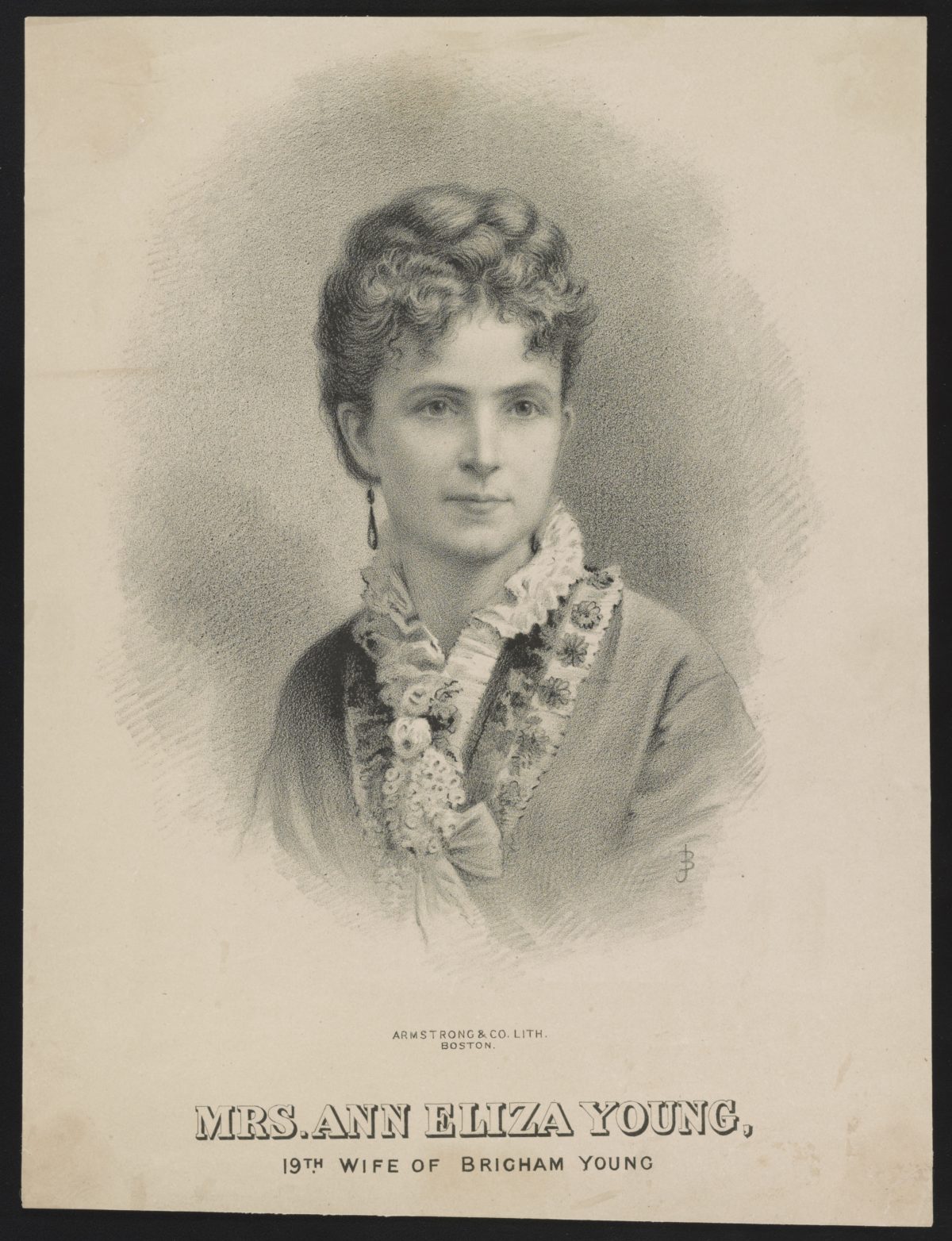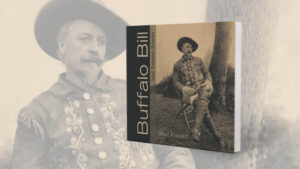She could feel his eyes on her face. Modestly, she looked down. But, as if hypnotized, her glance kept returning to his as he preached. “The steady eyes would always bring mine back,” she said. “I felt his power then as I had never felt it before.” This man was the godlike Lion of the Lord, ruler of the Territory of Utah. He was 64; she was 21. He was the Prophet; she was the daughter of a carriage maker. Now he wanted her. “O Mother,” she pleaded, “to give myself to a man older than my father, from whom I shrink in aversion when I think of him as my husband, who is already the husband of many wives, the father of children older, by many years, than myself…” She shuddered. “O Mother, I can’t, I can’t!”
Reader, she married him.
And then she sued him.
Ann Eliza Webb was no schoolroom miss when Brigham Young asked for her hand. A chestnut-tressed, clear-complected beauty, she was an actress and a divorcée, the mother of two. Her life had been entwined with Young’s since he dandled her on his knee, when he had taken over the leadership of the Church of Jesus Christ of Latter-day Saints (or LDS). The couple would be joined until 1876, when she published her tell-all Wife No. 19, on which is based much of this Histrionic History of a Scandal that Shook a Pillar of the Mormon Temple: Polygamy.
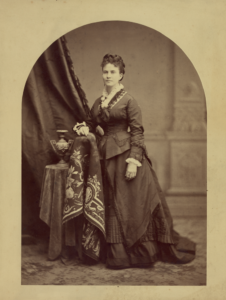
Chapter 1: Joseph Smith Has Revelations & Is Murdered
Joseph Smith was a farm boy of 14 in Palmyra, N.Y., when he had his first religious experience. In the early 1800s, the area seethed with sects claiming the one true faith. Conflicted, Smith prayed for guidance, and a vision told him to join none. A few years later, Smith said, an angel calling himself Moroni appeared in his bedroom and told him “the fullness of the everlasting Gospel” was written on gold plates buried under a nearby rock. From behind a blanket—using two pebbles, Urim and Thummim, to translate from “reformed Egyptian”—Smith dictated the Book of Mormon, which was printed in 1830. The 275,000-word tome told of ancient tribes from Babylon and Jerusalem that settled America thousands of years before the birth of Christ, and predicted the Second Coming. Before being taken to heaven, the gold plates were revealed to a handful of followers.
Skeptics abounded. One Methodist minister to whom Smith related his vision snapped that “such things had ceased with the Apostles.” Mark Twain said the Book of Mormon was “chloroform in print. If Joseph Smith composed this book, the act was a miracle—keeping awake while he did it was, at any rate.”
GET HISTORY’S GREATEST TALES—RIGHT IN YOUR INBOX
Subscribe to our HistoryNet Now! newsletter for the best of the past, delivered every Monday and Thursday.
The era was a fertile one for charismatic Christianity. Many utopian communities had beliefs about the Second Coming; many about sex. The Oneida commune believed the Second Coming had occurred in 70 ad and practiced “complex marriage” in which anyone could have sex with anyone. The Shakers, whose leader claimed to be the reincarnation of Christ in female form, did not believe in having sex at all. Joseph Smith took the command to “be fruitful” literally. Among competing sects, the surest way to generate a steady supply of believers—and settlers—was to breed them up.
Chauncey and Eliza Webb, Ann Eliza’s parents, met at Smith’s first utopian community in Ohio in 1835. When Smith was driven from the state in a banking scandal in 1838, they followed him to Missouri in search of the original Garden of Eden. They were hounded from Missouri, too, and rebuilt the community again in Nauvoo, Ill.
Ann Eliza was a babe in the womb when Smith had a revelation requiring Mormon men to take multiple wives. He wed a dozen young converts and ordered that other prominent Saints follow his example. As news of the polygamy leaked out, a news sheet published by a former church leader accused Smith of “abominations and whoredoms.” In 1844, Smith challenged the political establishment by campaigning to become president of the United States. The Illinois governor charged him with treason. Smith surrendered. The next day a mob attacked the jail and shot him dead.
Chapter 2: Brigham Young Brings Tears to Ann Eliza’s Home
“I was consecrated to sorrow by the baptism of my mother’s tears,” wrote Ann Eliza, who was born two months after Smith’s death. “I came to her when the greatest misery of her life was about to fall on her.” That misery was a visit to the Webb home by Brigham Young, who had succeeded the martyred Smith, to tell Chauncey that he must take another wife. Immediately.
Chauncey, 33, left it up to his devoted wife, Eliza: Should they leave the church or would she share her husband with another? Fearful of disobeying the Prophet, Eliza chose their 19-year-old boarder. But when her husband took the girl to bed, Eliza contemplated suicide. Ann Eliza now had two mothers; eventually, she would have five.
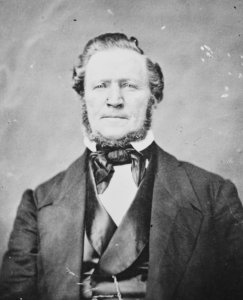
Young himself married 11 women in less than a month, several of them Smith’s widows. There were wives, and then there were wives, which accounts for discrepancies in various tallies of Young’s unions. Some wives were “for time”—for now, in this life. Some wives were “celestial”—bonded for eternity, forever. Some he had sex with, some he did not—though it’s hard to know which was which except by whether the unions produced children. Some were widows he married as a proxy so that they could be reunited with their dead husbands in the afterlife. Some were widows past childbearing age who needed support. His lifetime total would be 56 wives.
Beginning in 1846, 20,000 Saints pulled up stakes in Illinois, and headed to the desolate desert near Salt Lake, then a territory of Mexico. Chauncey, in charge of building the wagons for the exodus, arrived in 1848 with the final group of 397 wagons, 1,229 people, 1,275 oxen, 699 cattle, 74 horses, 82 dogs, 37 cats, 5 beehives and a squirrel. Young met them, and Ann Eliza’s 4th birthday was celebrated. Sighed she, “I little thought then what relation I should one day hold to this man.”
Recommended for you
Chapter 3: A Headstrong Beauty Captivates the Lion
An astute businessman and inspired leader, Young guided his people to set down roots and prosper. Utah became a U.S. territory in 1850, and Young its governor. But federal officials feared the concentration of power, land and money in a group with separatist tendencies and did everything they could to bring Young and his burgeoning flock of Mormons to heel, even sending in troops.
The Prophet should have had little energy to monitor the doings of our Heroine. But at age 17, she relates, “He seemed suddenly to realize that I had grown to be a young lady, and the first intimation he gave of it was by interfering with my beaux.” One day, he saw her on the arm of one of his brothers-in-law and told Ann Eliza’s mother to cut the connection. When Ann Eliza complained, a girlfriend teased, “Perhaps Brother Brigham means to marry you himself.”
“I wouldn’t have him if he asked me a thousand times—hateful old thing,” sniffed Ann Eliza.
Not long afterwards, Young’s carriage pulled alongside. He drove her home and said, “I heard you said you wouldn’t marry me if I wanted you to ever so much.”
Ann Eliza was flustered.
Young subsequently tapped Ann Eliza for the company in his new Salt Lake City theater. Since her family lived out of town, she spent most nights in his Lion House. The dorm-like structure housed about a dozen of Young’s wives. There were suites for women with children, parlors and a dining hall for 50. (Today, the building contains restaurants.) An actress of indifferent talent, Ann Eliza joined Young’s daughters—he sired 31 girls and 25 sons—in chanting complaints about the meager and unvarying breakfast, “Bread and butter and peach sauce!”
Next door was the Bee Hive, where Young slept alone in his austere, 16-foot-square bedroom and worked in an office that opened into the Lion House. Hearsay claimed a chalk mark on a bedroom door designated that night’s chosen wife. Young said his visitors—from Buffalo Bill to Sinclair Lewis—wondered who he slept with. He told the curious: “I slept with all that slept and we slept in one universal bed—the bosom of our mother earth.”
Chapter 4: An Aside About a Short-Lived Love Match
Ann Eliza fell in love with James Dee, a Mormon a little older than herself. Young didn’t interfere: He had just married Amelia, who made it clear from the outset that she intended to rule the roost.
Ann Eliza and James stood before their Prophet, and he “sealed” them to each other. “I pronounce you, legally and lawfully husband and wife, for time and for all eternity,” said Young.
Marital bliss did not last. The newlyweds quarreled. He threatened her with more wives; she heaped him with reproaches. While Ann Eliza was pregnant with their second son, Dee “seized me by the throat,” and Ann Eliza’s father threw him out. Young procured a cancellation of their sealing in 1865. A son of Dee’s second marriage claimed that Ann Eliza’s mother said, “You get a divorce from Dee, and I’ll get you married to Brigham Young.”
Chapter 5: A Prophet’s Proposal Is Accepted
“You are very much improved since you left Mr. Dee,” Young said, as he walked Ann Eliza home following the meeting in church at the outset of this History. “You are a very pretty woman.” Ann Eliza said she would never remarry. “Never in my life.” “When you do marry, select some man older than yourself,” Young advised. “Respect is better than romance any day.”
That day, he asked her parents for her hand, offering her “a good house, well furnished and $1000 a year pocket money.” Ann Eliza spurned her suitor for two years, until a soured business deal left her older brother in debt to Young. Likely her father, as well, didn’t want to support Ann Eliza and her two sons for the rest of their lives. Perhaps her mother, too, never truly resigned to her husband’s other wives, wanted to get out of the family home. “There was nothing but ruin in store,” wrote Ann Eliza dramatically. “My religion, my parents—everything was urging me on to my unhappy fate.”
Alas the Heroine of our Romance may not be entirely sympathetic—or entirely truthful. “Father did not want to marry Ann Eliza,” Young’s daughter Susa wrote years later. “She teased Father through her mother for several years to marry her, suggesting a nominal union. He protested that he was an old man and wanted no more wives.” A daughter doesn’t always know her father’s heart, however. Young had not considered himself too old to marry a young Englishwoman six months before—by Ann Eliza’s count, his 18th wife. His 17th and, in recent years, favorite wife, Amelia, was furious about that marriage and certainly wouldn’t welcome another.
Young, then 66, and Ann Eliza, 23, were joined by Heber C. Kimball, who once warned the Mormon leader, “Some day there’ll be one new wife who’ll give you trouble.” April 7, 1868, was that day. Ann Eliza considered herself Young’s 19th living, conjugal wife, counting those who stayed with him in the Beehive and those he had established nearby in the multi-gabled Lion House or other living quarters.
Young escorted Ann Eliza home to her father’s house after the wedding ceremony and slept alone in his room.
Chapter 6: Into the Lion’s Den, or for Want of a Stove
Young established Ann Eliza and her two sons in a separate house, and her mother joined them, leaving Chauncey with his other wives. After admitting the marriage to his harem, Young insisted that Ann Eliza attend dinner and prayers at the Lion House. She dreaded facing her “sister wives.” Typically, Young’s latest favorite ousted her predecessor, who then moved into a house of her own with her children. Some of the older wives who had been deposed hoped Ann Eliza would put Amelia’s nose out of joint—the favorite was said to smash furniture.
The first time they encountered each other in person, Amelia slammed the garden gate in her latest rival’s face and walked away. Ann Eliza was clearly no competition. Jealous of her privileges, Amelia would retain her position as queen bee for the remainder of Young’s life.
At first, the Prophet seemed to be quite interested in his new bride and visited her often. He took her to balls—he loved the quadrille but banned the wanton waltz. Ann Eliza was miffed, however, that he never escorted her without another wife or two.
The attention Young paid Ann Eliza was shortlived. Miserly rations came monthly: a bit of pork, 5 pounds of sugar, a pound of candles, one box of matches, one bar of soap, with her sons allotted a hat and a pair of shoes each year. The promised pin money never materialized. She fell ill. He didn’t care.
Young had promised to build her a house that had no stairs in the parlor, her personal bugbear. But then he built stairs in the parlor. Ann Eliza craved the furs and gewgaws he bestowed on Amelia and other wives as tokens of his affection, protesting, “It was more than a woman’s nature could stand to see them thus petted.”
Then he came to call no more.
Ann Eliza took in boarders. Most were Gentiles, the first non-Mormons she had met, including a judge, a Methodist minister and a reporter. They opened her eyes and gave her a glimpse of a different world. “In addition to the dread and dislike which had grown up in my heart towards my husband,” she said, “I was beginning to lose faith in the religion which he represented.”
She begged her husband for a new stove. He refused.
After four years of wedlock, Ann Eliza asked her boarders to help her get a divorce.
Chapter 7: Our Heroine Escapes With Her Life & Little Else
My plans were quickly laid,” Ann Eliza scribbled, “before they could be discovered by Mormon spies.” At dawn, horse-drawn moving vans appeared at her house and took her furniture to auction. She holed up in a hotel. “I fully believed that was to be my last night on earth,” she said. “I had abandoned my religion, left father, mother, home and friends.”
Ann Eliza hit Young in the pride and in the pocketbook. In the formal complaint, she claimed he cohabited with her for about a year after the marriage. She sued for divorce on the grounds of “cruel and inhuman treatment” and “desertion,” demanding $200,000 plus legal fees. At first Young was unruffled—he had granted divorces, most of them amicable, to 10 wives. But this divorce case quickly became an international scandal.
“Polygamy has received a heavy blow,” intoned the New York Times. “The 17th [sic] wife of Brigham, the Prophet, has thrown off her allegiance.” The public was already muttering about “Modern Mohammedanism.” One of Young’s daughters-in-law had called Salt Lake City “the biggest whorehouse in the world.” Mormons countered that they had no prostitutes, no spinsters, no mistresses. “There is a conspiracy under way to take from us our lands and our money,” Young stated. “It is simply a case of blackmail, in which they have secured the alliance of my wife.”
Legal battles postponed the divorce for two years. Meanwhile, Ann Eliza had no money to live on. A Mormon teacher suggested to her that if she returned to Young, an angel might whisper in his ear and make her the favorite.
She shouted, “Well, I don’t want the angel to do any such thing!”
Chapter 8: An Angry Woman Becomes a National Sensation
Reporters beat down Ann Eliza’s door. She enlisted a former boarder, Major James Burton Pond, to manage a national lecture tour. The thought of being a celebrity, “having my name on every vulgar lip,” revolted her at first. “When it was shown me that I might make myself a power against Mormonism,” however, “I hesitated no longer.” Our Heroine slipped out of town in the dark of night, escorted by her father. She boarded the train. But she would not escape her past: She needed it.
Denver, Topeka, Chicago, Boston. The titillating tale of the 19th wife delivered in lectures drew standing-room-only crowds. The audience was surprised to learn that Mormons claimed Adam had many wives, of whom Eve was one, and that “the love of Jesus for Martha and Mary, her sister, as well as Mary Magdalene, showed that they were his plural wives.” Gasps. Mrs. Young brought stagecraft to her lectures—she even had laugh lines. Young, she said, told her “to marry some good brother whom I could look up to for counsel.” Pause. “By the way, the only good counsel I ever received from him was to practice the strictest economy.” Laughter.
She was a sensation. There was the hint of scandal when the Chicago Times shrieked that Ann Eliza and her manager were having an affair. The pair blamed the rumors on the LDS church. Notoriety did not interfere with Ann Eliza’s triumphal progress to Washington, D.C., in 1874, where she charmed congressmen and President Ulysses S. Grant, who came to hear “My Life in Bondage.”
The president signed one of many bills designed to end polygamy—and reduce Mormon power—a few weeks later.
Ann Eliza was able to support her mother and two sons in New York State with the money she made while she was on the lecture tour. When she spoke in Salt Lake City, the front rows were packed with Young’s daughters and daughters-in-law—to intimidate her, Ann Eliza believed. She was apostate, and her parents were excommunicated by church elders for their support of her. Chauncey, who remained in Utah, was later rebaptized.
Chapter 9: Another Revelation & the End of Our Romance
Brigham Young, the Mormon Moses, led his church safely through the most vulnerable period in its history. A visionary who built canals, cities, temples and universities, including the one that bears his name today, Young fiercely protected his flock, who have indeed flourished and multiplied. Today there are 6.5 million members of the LDS church in the U.S. and 14 million worldwide. In the end, Young was not bested by his wayward bride. He was jailed overnight for contempt of court as divorce proceedings dragged on and finally paid Ann Eliza a pittance in 1876. He died in 1877, calling out, “Joseph, Joseph, Joseph!” Of his 56 wives, 19 predeceased him and 23 survived him. He was divorced from 10, and the status of four is unknown. His will specified a $1 million trust for the 16 surviving conjugal wives. Amelia inherited a new mansion.
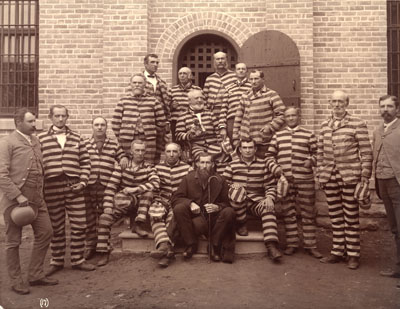
Public sentiment continued to condemn plural marriage. Though personally abhorring the practice, one senator yet argued prophetically, “The feeling that exists today against polygamy, may exist tomorrow against any church, against any class in this broad land.” Polygamy was ultimately ruled unconstitutional by the Supreme Court in 1878, and witch hunts followed. Some polygamists were relieved of their fortunes, some moved to Mexico, some went underground. (Researchers at Brigham Young University estimate that 20,000 to 50,000 fundamentalist Mormons illegally practice plural marriage today). Prophet Wilford Woodruff made a deal with President Grover Cleveland: He agreed to forbid polygamy in return for statehood, amnesty and return of escheated church property. Woodruff gathered the elders in 1890 and revealed that plural marriage must cease. The last to speak was Joseph F. Smith, a nephew of the first Prophet. Tearfully, he said, “I have never disobeyed a revelation from God. I cannot—I dare not—now.” Utah became a state in 1896.
Alas for our Heroine, once the battle to bring down polygamy was won, she passed into obscurity. She became a Methodist and then a Christian Scientist. She married a wealthy banker from Michigan but divorced him when she caught him with a housemaid. A reissue of her memoirs emerged in 1908. But no record exists, even in the renowned Mormon genealogical archive, of where her grave may lie.
Claudia Glenn Dowling logged 25 years as a writer at People and Life magazines.
historynet magazines
Our 9 best-selling history titles feature in-depth storytelling and iconic imagery to engage and inform on the people, the wars, and the events that shaped America and the world.


